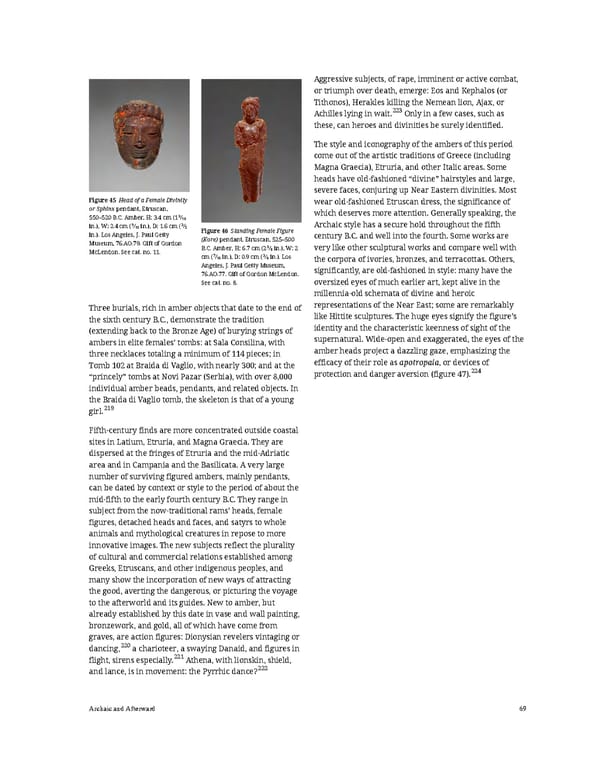Aggressive subjects, of rape, imminent or active combat, or triumph over death, emerge: Eos and Kephalos (or Tithonos), Herakles killing the Nemean lion, Ajax, or Achilles lying in wait.223 Only in a few cases, such as these, can heroes and divinities be surely identified. The style and iconography of the ambers of this period come out of the artistic traditions of Greece (including Magna Graecia), Etruria, and other Italic areas. Some heads have old-fashioned “divine” hairstyles and large, severe faces, conjuring up Near Eastern divinities. Most Figure 45 Head of a Female Divinity wear old-fashioned Etruscan dress, the significance of or Sphinx pendant, Etruscan, which deserves more attention. Generally speaking, the 550–520 B.C. Amber, H: 3.4 cm (13⁄10 in.), W: 2.4 cm (9⁄10 in.), D: 1.6 cm (3⁄5 Archaic style has a secure hold throughout the fifth in.). Los Angeles, J. Paul Getty Figure 46 Standing Female Figure century B.C. and well into the fourth. Some works are Museum, 76.AO.79. Gift of Gordon (Kore) pendant, Etruscan, 525–500 B.C. Amber, H: 6.7 cm (25⁄8 in.), W: 2 very like other sculptural works and compare well with McLendon. Seecat. no. 11. cm (7⁄ in.), D: 0.9 cm (3⁄ in.). Los 10 8 the corpora of ivories, bronzes, and terracottas. Others, Angeles, J. Paul Getty Museum, significantly, are old-fashioned in style: many have the 76.AO.77. Gift of Gordon McLendon. Seecat. no. 8. oversized eyes of much earlier art, kept alive in the millennia-old schemata of divine and heroic Three burials, rich in amber objects that date to the end of representations of the Near East; some are remarkably the sixth century B.C., demonstrate the tradition like Hittite sculptures. The huge eyes signify the figure’s (extending back to the Bronze Age) of burying strings of identity and the characteristic keenness of sight of the ambers in elite females’ tombs: at Sala Consilina, with supernatural. Wide-open and exaggerated, the eyes of the three necklaces totaling a minimum of 114 pieces; in amber heads project a dazzling gaze, emphasizing the Tomb 102 at Braida di Vaglio, with nearly 300; and at the efficacy of their role as apotropaia, or devices of “princely” tombs at Novi Pazar (Serbia), with over 8,000 protection and danger aversion (figure 47).224 individual amber beads, pendants, and related objects. In the Braida di Vaglio tomb, the skeleton is that of a young girl.219 Fifth-century finds are more concentrated outside coastal sites in Latium, Etruria, and Magna Graecia. They are dispersed at the fringes of Etruria and the mid-Adriatic area and in Campania and the Basilicata. A very large number of surviving figured ambers, mainly pendants, can be dated by context or style to the period of about the mid-fifth to the early fourth century B.C. They range in subject from the now-traditional rams’ heads, female figures, detached heads and faces, and satyrs to whole animals and mythological creatures in repose to more innovative images. The new subjects reflect the plurality of cultural and commercial relations established among Greeks, Etruscans, and other indigenous peoples, and many show the incorporation of new ways of attracting the good, averting the dangerous, or picturing the voyage to the afterworld and its guides. New to amber, but already established by this date in vase and wall painting, bronzework, and gold, all of which have come from graves, are action figures: Dionysian revelers vintaging or dancing,220 a charioteer, a swaying Danaid, and figures in flight, sirens especially.221 Athena, with lionskin, shield, and lance, is in movement: the Pyrrhic dance?222 Archaic and Afterward 69
 Ancient Carved Ambers in the J. Paul Getty Museum Page 78 Page 80
Ancient Carved Ambers in the J. Paul Getty Museum Page 78 Page 80